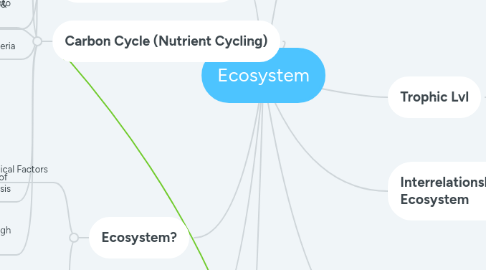
1. Decomposers (Chemical)
1.1. Decomposing
1.1.1. Breaking down of complex minerals into small, simpler and soluble substances
1.2. Break down complex nutrients in faeces and bead bodies and animals into simpler and soluble substances (carbon dioxide into atmosphere& soluble mineral salts into soil)
1.3. E.g. Fungi & Bacteria
2. Carbon Cycle (Nutrient Cycling)
2.1. Nutrients are not lost by recycled continually
2.2. Carbon is released & removed into the atmosphere continually
2.2.1. Removed
2.2.1.1. Photosynthesis
2.2.1.1.1. Green plants absorb carbon dioxide from the atmosphere and use it to produce carbon compounds
2.2.1.2. Feeding
2.2.1.2.1. Animals feeding plants or other animals the carbon compounds becomes apart of their bodies during respiration
2.2.1.3. Formation of Fossil Fuels
2.2.1.3.1. Carbon compounds are preserved as fossil fuel and burnt to provide energy
2.2.2. Released
2.2.2.1. Respiration
2.2.2.1.1. Carbon compound (glucose) are broken down into carbon dioxide
2.2.2.2. Combustion
2.2.2.2.1. When fossil fuels such as coal and natural gas release carbon dioxide
2.2.2.3. Decomposition
2.2.2.3.1. When organism pass on, dead matter is broken down by decomposers into simpler, small and soluble substances
2.3. Ensures the continuous supply of carbon dioxide for photosynthesis
2.3.1. Photosynthesis converts light to energy into chemical energy in food (producers)
2.4. Enables energy to flow through ecosystem
2.4.1. Carbon compounds carry trapped energy passed from one organism to another in a food chain
3. Ecosystem?
3.1. Physical Factors
3.1.1. Light intensity
3.1.2. Availability of water level
3.1.3. Temperature of the surrounding
3.1.4. Places to hide from dangers
3.1.5. Minerals available
3.1.6. Acidity and alkalnity
3.1.7. Changes in environmental conditions or one populations affect the other population which disrupt the stability of ecosystem
3.1.8. Habitat of organisms
3.2. Made up of the interactions between a community and its physical environment
3.2.1. Community
3.2.1.1. Different populations of plants and animals living and interacting in a particular environment
3.2.2. Population
3.2.2.1. Organism of the same kind living together in the same environment
3.2.3. Organism
3.2.3.1. An species (Adapted to the environment it lives in)
4. Adaptations
4.1. Structural Adaptations
4.1.1. Physical characteristics of an organism that helps it to survive in its habitat
4.2. Behavioural Adaptations
4.2.1. Different behaviour under the new conditions will die
5. Food webs
5.1. shows one or more food chains are interconnected
5.2. Helps to see where photosynthesis, respiration and feeding are involved in the flow of energy and nutrients in the ecosystem
6. Energy
6.1. Transferring from an organism to a food chain or web through feeding
6.2. Amount of energy transferred along the food chain decreases as energy is lost at and between trophic level
6.2.1. Respiration
6.2.2. Excretory Products
6.2.3. Faeces & Urination
7. Trophic Lvl
7.1. Producer
7.1.1. Produces food stored as chemical potential energy by the conversion of light energy
7.2. Primary
7.2.1. Feeds in producer to obtain energy and nutrients
7.3. Secondary
7.3.1. Feeds on primary consumers for energy and nutrients
7.4. Tertiary
7.4.1. Feeds on secondary consumers to obtain energy and nutrients
7.5. 4 lvls?
7.5.1. Energy is lost mainly as heat (during respiration) at each trophic level. This means less energy is available for the organism in the next level. Hence, there is insufficient energy to be passed to the last trophic level
8. Interrelationships in an Ecosystem
8.1. Predator-prey relationship
8.1.1. Predators hunt and kill their prey for food
8.2. Mutualism
8.2.1. Two/more organism support or benefit one another
8.3. Parasitism
8.3.1. Parasite is an organism that causes harm to another organism (host) without killing it
